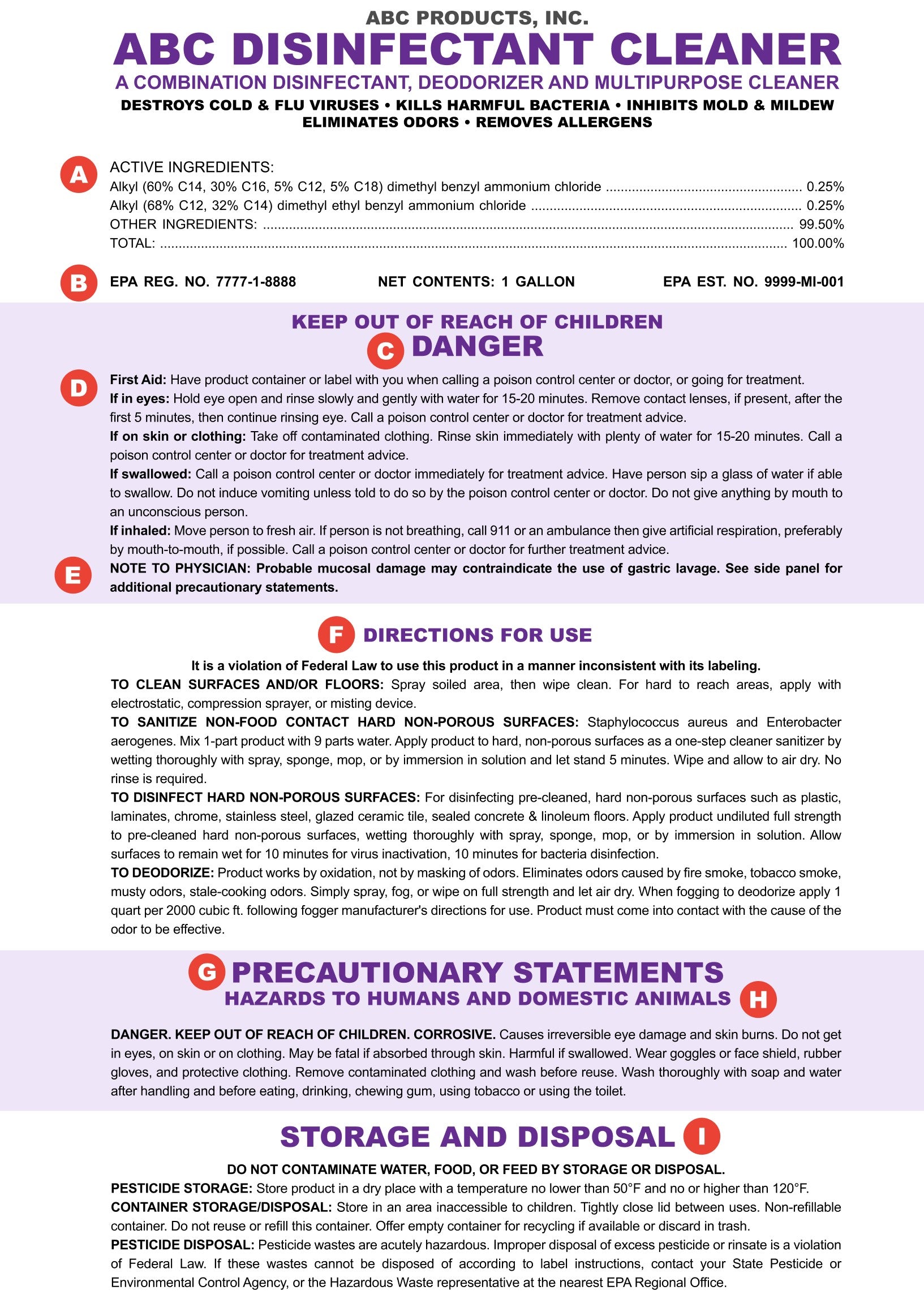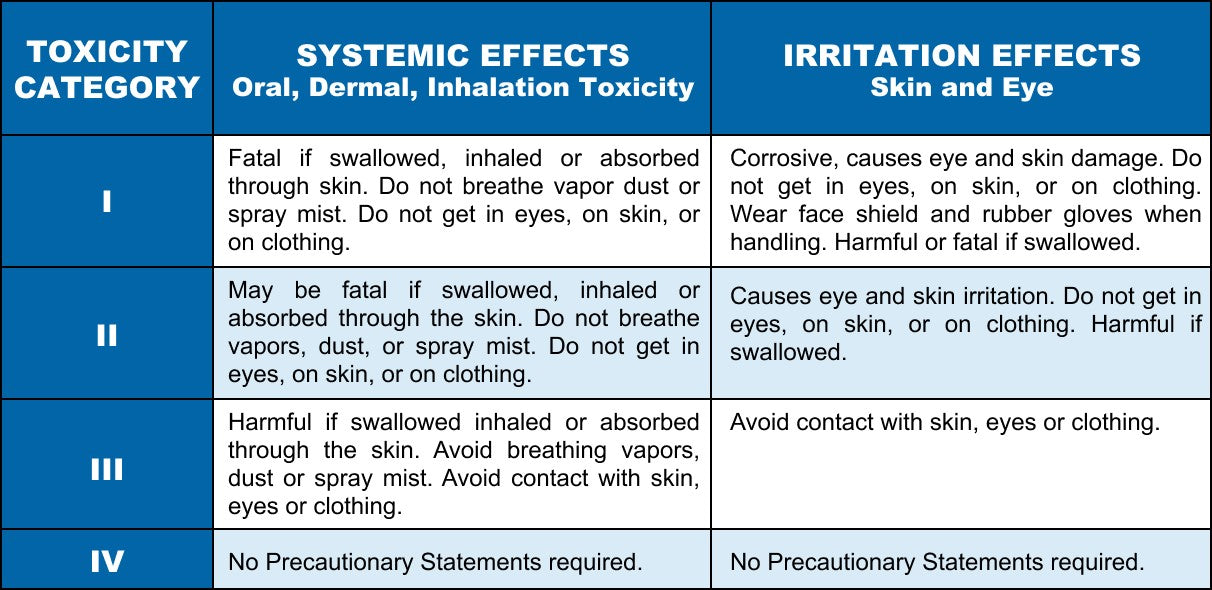Before any Antimicrobial Product can be offered for sale in the U.S., it must first complete the EPA's antimicrobial product evaluation and registration process. To qualify for registration, each product undergoes extensive analysis, the results of which must support its germ-kill and other performance claims, and comply with the EPA's safety, efficacy, and quality standards. Antimicrobials that satisfy these requirements are ultimately issued an EPA Registration Number, as well as a corresponding EPA approved product bottle label, which must display this newly issued EPA Registration Number.
Antimicrobial product labels include the product’s EPA reviewed and approved germ-kill, and other efficacy claims, its approved uses, use sites and surfaces, directions for use, precautionary statements, hazard warnings, and other product and product manufacturer information.
When it comes to understanding what a particular antimicrobial product’s capabilities are, it is essential to remember that only the approved product uses, use sites and surfaces, germ-kill and other performance claims, that are specifically listed on its bottle label are true and accurate.
For example, if you’re reviewing various disinfectant labels searching for one that:
- Eliminates harmful bacteria on surfaces the EPA refers to as “Soft Surfaces,” which includes upholstered furniture, carpets, curtains, clothing, footwear, mattresses, bedding, stuffed animals and other toys, vehicle interiors, all fabrics and textiles, and many more, and “Soft Surface Sanitization” isn’t specifically listed on its label …
- Both cleans and disinfects surfaces in one step, and does so without the need to rinse treated surfaces with water before or after it’s applied, and “Cleans and Disinfects Surfaces in One Step” isn’t specifically listed on its label …
- Cleans and sanitizes “Food Contact Surfaces,” which include glassware, dishes, utensils, cookware, countertops, prep-tables, can-openers, slicers, mixers, kitchen appliances, and every other item used to prepare, cook, serve or consume food or beverages, and “Food Contact Surface Sanitization” isn’t specifically listed on its label …
- Cleans and disinfects sensitive everyday surfaces, such as computers, key boards, cell phones, touch-screens and other electronic devices, and these specific items are not listed under “Approved Use Sites and Surfaces” on its label …
- Can be applied with a “fogger” for disinfection, an application method that reduces application times by as much as 80%, while increasing the coverage rate per gallon of disinfectant by a whopping 900%, and “Disinfection by Fogging” isn’t specifically listed on its label ……
... then that disinfectant is either not capable of safely or effectively accomplishing the desired task, or it has otherwise failed to satisfy the EPA's testing standards for that use. Regardless of the reason, it cannot be used for such purposes. Further, as displayed on every bottle of every antimicrobial product sold in the U.S., using an antimicrobial “in a manner inconsistent with its labeling is a violation of Federal Law.”
NOTE: We are proud to report that PermaSafe CLEAN is EPA registered, and approved for each and every one of the above uses, and thousands more! Learn more about antimicrobial product labels and how the EPA regulates them.
DECODING DISINFECTANT PRODUCT LABELS

A. ACTIVE INGREDIENTS: This section reveals the product’s primary antimicrobial, or “germ-killing,” agents.
B. EPA REG. NO: This is an abbreviation for “EPA Registration Number,” with the digits following it being the product’s actual EPA Registration Number, which serves as evidence that it has successfully completed the Environmental Protection Agency’s antimicrobial product evaluation and registration process, a legal requirement before it can be offered for sale or used in the U.S.
C. SIGNAL WORDS: As part of their antimicrobial evaluation and registration process, the EPA assigns each product a “Signal Word” that indicates the degree of risk, or potential hazards associated with that product, based upon its toxicity in the event it is swallowed, inhaled, or absorbed through the skin. The following are the three Signal Word options that may be assigned to an antimicrobial product, from the least harmful to the most harmful: CAUTION, WARNING, DANGER-POISON.
NOTE: Due to its unique safety profile and Category IV EPA Toxicity Rating, which is the very lowest rating any antimicrobial product can be awarded, PermaSafe CLEAN is one of the very few disinfectants that does not require any Signal Words on its labels.
D. FIRST AID: This section contains instructions for administering, and assisting with First Aid in the event of product exposure through various routes, such as accidental swallowing, inhalation or skin contact. As is the case with most other label instructions, their volume and depth are primarily based on the product’s toxicity and other associated hazards.
E. NOTES TO PHYSICIAN: This First Aid subsection is only necessary when specific medical information is needed by medical professionals in the event of poisoning or other exposure to the product.
NOTE: Due to its safety profile and Category IV EPA Toxicity Rating, PermaSafe CLEAN’s First Aid section is limited to: “If in eyes: Hold eye open and rinse slowly with water 15-20 mins. Remove contact lenses after first 5 mins. and continue rinsing.” No “Notes to Physician” are required on CLEAN’s labels.
F. DIRECTIONS FOR USE: An antimicrobial product’s directions for use typically include:
Product Preparation: Most antimicrobial products are Ready To Use (RTU) as received, yet some will require mixing, and others will offer dilution options for specific tasks that can be achieved with a less concentrated formulation, therefore reducing overall product costs. No matter what a product’s preparation requirements are, if any, such information will appear in its Directions for Use section.
Where to Use / Approved Use Surfaces: Due to the many types of materials and surfaces that exist, the EPA separates all materials into three (3) basic Types of Surfaces: “Hard, Non-Porous,” “Soft and Porous”, and “Food Contact.” Surprisingly however, very few disinfectants or other antimicrobials are EPA registered for use, or can safely or effectively eliminate germs on the materials and surfaces most of us are in contact with most often. Why understanding surface specifics is the key to antimicrobial success.
Product Application Methods: The EPA stipulates various application methods for antimicrobial products based upon their chemical properties and intended uses. Application methods usually include wetting surfaces by use of a spray bottle, mechanical spray device, sponge, mop, immersion, or a ULV or Electrostatic fogger. Note that fogging is by far the fastest, most efficient method, and can reduce application times by up to 80%, while increasing coverage rates by as much as 900%. However, due to the “fog” they generate, which can remain airborne and therefore breathable for an hour or more, and the toxicity of most disinfectants, very few are approved for application by fogging.
Required PPE: While sometimes located in other label sections, a product’s Directions for Use will usually state the PPE (Personal Protection Equipment), such as gloves, masks, eye protection, etc., that users are required to wear to ensure their safety when preparing or applying the product.
Specific Directions for Specific Uses: Some antimicrobial products are formulated for multiple purposes, which may include cleaning, sanitization, disinfection, deodorization, mold remediation, and/or similar purposes, on any of a variety of different surfaces, such as Hard Surface Sanitization, Soft Surface Sanitization and Food Contact Surface Sanitization. A product’s Directions for Use must list, and include separate instructions for each such specific purpose.
Contact Time: “Contact,” or “Dwell Time” refers to the amount of time a disinfectant or other antimicrobial product must remain wet on a specific surface to effectively achieve a given level of germ reduction, such as sanitization or disinfection.
G. PRECAUTIONARY STATEMENTS: Among other various standards, the EPA categorizes antimicrobial products based upon their toxicity, from Category I, the highest toxicity category, to Category IV, which represents the very lowest toxicity. Labels for all Category I, II and III rated antimicrobial products must include the words “PRECAUTIONARY STATEMENTS” on their labels to alert users to the product’s toxicity.

H. HAZARDS TO HUMANS AND DOMESTIC ANIMALS: This section, which must appear with, and immediately follow the PRECAUTIONARY STATEMENTS heading, describes the hazards to humans and animals associated with the use of, or exposure to the product. It also informs users of the personal protection equipment that should be worn when applying the product, provides specific information regarding the product’s toxicity, irritation and sensitization risks, and offers guidance on treatment and ways to minimize the possibility of exposure.
NOTE: PermaSafe CLEAN, like all PermaSafe antimicrobial products, is EPA rated Category IV for toxicity, a true rarity in this industry. Category IV is the very lowest toxicity rating any antimicrobial product can be awarded, and one that equates to “virtually non-toxic and not an irritant.” It also means no gloves or other personal protection equipment are necessary when applying it, no wiping or rinsing is required after it’s applied, even on Food Contact Surfaces, and no Precautionary Statements or Hazard Warnings are required on its labels
TYPICAL HUMAN HAZARDS AND PRECAUTIONARY STATEMENTS

I. STORAGE AND DISPOSAL: This section provides instructions for storing the product, disposing of any unused product, and for the proper disposal of the container the product originally came in. Like most other label sections, this one too offers some insight as to the product’s toxicity and other potential hazards.


